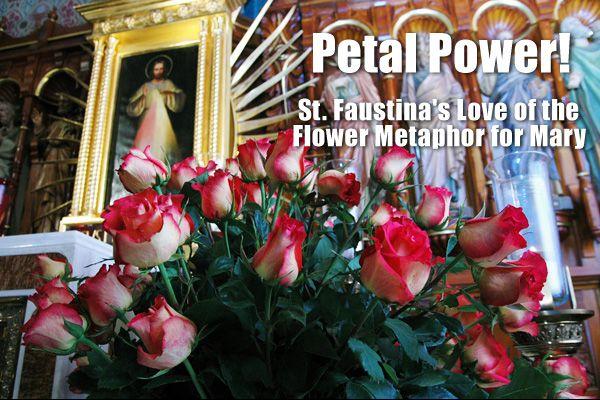
The following excerpt is taken from Purest of All Lilies: The Virgin Mary in the Spirituality of St. Faustina (Marian Press), the new book by Fr. Donald Calloway, MIC.
When considering the Virgin Mary and her place in the spiritual life, it makes perfect sense that flowers often have been named after her and used as metaphors for understanding her maternal role and the devotion due to her. One only has to think of that most beautiful of prayers, the Rosary.
Father Lucius McClean, in the introduction to the book by Mabel Maugham (Beldy), Our Lady's Flowers, notes the following concerning the connection between Mary and flowers:
From the earliest Christian times, flowers have been associated with Our Lady. The Liturgy constantly stresses this association, and Christ's people have been long used to calling Mary by such names as "The Lily of the Valley" and "Mystical Rose." Flowers symbolizing virtues like modesty, humility, purity, love, have been, as it were, dedicated to her.
Before delving into St. Faustina's particular use of floral images in describing Mary, it is important to note the overall application that St. Faustina gave to flowers in her spiritual writing. She will often times describe herself as a flower in order to highlight some particular aspect of her spiritual life. For example, she seemed to have understood certain kinds of flowers as representing various aspects of the spiritual life: humility = violet, love = rose, purity (and suffering) = lily. Of these three, the lily was St. Faustina's favorite flower. Therefore, this section, while briefly presenting St. Faustina's metaphorical use of the violet and the rose, will focus primarily upon her fascination with the lily.
Concerning humility, St. Faustina gave clear statements that humility is a lovely flower (see Diary of St. Faustina, 275, 296, 306, 1306), and the following examples show how she associated this virtue with the violet:
I will hide myself among the sisters like a little violet among lilies. I want to blossom for my Lord and Maker, to forget about myself, to empty myself totally for the sake of immortal souls (224).
I want to be a tiny violet, hidden in the grass, unknown in a magnificent enclosed garden in
which beautiful lilies and roses grow. The beautiful rose and the lovely lily can be seen from afar, but in order to see a little violet, one has to bend low; only its scent gives it away (591).
I will hide from people's eyes whatever good I am able to do so that God Himself may be my reward. I will be like a tiny violet hidden in the grass, which does not hurt the foot that treads on it, but diffuses its fragrance and, forgetting itself completely, tries to please the person who has crushed it underfoot (255).
Concerning love, St. Faustina associated this virtue with both a rose and her very own heart, often times described as a beautiful garden. For example, in her Diary, we read the
following passages:
O my divine Bridegroom, the flower of my heart and the scent of my pure love are for You (591).
Jesus, behold my heart which is for You a dwelling place to which no one else has entry. You alone repose in it as in a beautiful garden (1385).
I cast myself as a little rosebud at Your feet, O Lord, and may the fragrance of this flower be known to You alone (239).
I want to live pure as a wild flower; I want my love always to be turned to You, just as a flower that is always turning to the sun. I want the fragrance and the freshness of the flower of my heart to be always presevered for You alone (306).
Under the influence of His rays, my soul has become covered with verdure, flowers, and fruit, and has become a beautiful garden for His repose (605).
O my most sweet Master, good Jesus, I give You my heart. You shape and mold it after Your liking. O fathomless love, I open the calyx of my heart to You, like a rosebud to the freshness of dew. To You alone, my Betrothed, is known the fragrance of the flower of my heart (1064).
The above examples of the metaphor of her love being like a rose manifest the depths of St. Faustina's heartfelt devotion to Christ. As a matter of fact, Christ Himself noted to her on two occasions that He took delight in her heart as in a "rosebud at morningtide" (Diary, 1546) and a "garden enclosed" (581).
Concerning the virtue of purity, St. Faustina most definitely understood this to be imaged in the metaphor of the lily. However, what is perhaps most interesting is the fact that St. Faustina never explicitly called herself a lily. St. Faustina infers, as we will see in the next section, that she is a lily due to her virginity, but explicitly refers to Mary as a lily. Perhaps since she held purity to be so great in the spiritual life, she only refers to the love of Jesus and Mary as being lily-like.
One of the most comprehensive applications of the metaphor of flowers can be seen in the following passage:
My life is not drab or monotonous, but it is varied like a garden of fragrant flowers, so that I don't know which flower to pick first, the lily of suffering or the rose of love of neighbor or the violet of humility (296).
It is interesting that on one occasion when Jesus desired to show His love for St. Faustina, He miraculously changed a pot of boiled potatoes into a pot of roses (see Diary, 65), and, on the other hand, when Satan wanted to manifest his hatred for St. Faustina, he violently hurled a flowerpot to the ground, smashing it to pieces (see Diary, 411-412).
The fact that at age five, St. Faustina had a dream in which she was walking hand in hand with the Mother of God in a beautiful garden proves to be significant when we examine how later in life St. Faustina used the metaphor of flowers to describe the Virgin Mary. Saint Faustina's love and devotion to Mary was so intense during her life as a religious that she chose to describe Mary in terms that were familiar to herself. As a religious, St. Faustina had often been assigned to be the gardener in convents, and this gave her a familiarity with various flowers and their fragrances. In addition, in the month of May when flowers are in bloom, Marian devotions flourish in Poland; on one occasion, Faustina even noted that for her May devotions, she laid the flower of her silence at the feet of the Mother of God (1105).
In the history of Christianity, many scriptural verses, theological writings, and artists have used the lily as a metaphor for describing both the beauty and the purity of the Mother of God. Concerning artistic presentations, Fr. Lucius McClean, notes the following:
For the Old Masters [artists], plants and flowers proclaimed beliefs and dogmas of their faith. A lily in a pot in a picture of the Annunciation said that Mary's virginity remained intact even though she was becoming the Mother of God. A bower or spray of roses proclaimed what the Liturgy had already applied to her from Scripture, that she is the Mother of Fair Love. A bunch of grapes told the whole story of the Eucharist, of how the Precious Blood Christ had first taken from the virginal body of His Mother had been given for us on Calvary and to us in the Holy Communion.
Further indication of the power of Christian art to transmit theological truths and devotion concerning the Mother of God through the employment of the theological metaphor of flowers is provided by Vincenzina Krymow:
The lily was associated with the annunciation in Italian art early in the fourteenth century, especially in Florence, which had the lily as its emblem. During the fourteenth and fifteenth, centuries, the lily was sometimes depicted being carried by the archangel Gabriel. Later a vase of lilies, signifying Mary's purity, stood at her side. ... In the "Annunciation" attributed to Pietro di Giovanni Ambrosi, the angel holds three lily stalks to symbolize Mary's purity before, during and after the conception of her son.
These historical facts are important to keep in mind when considering the application of the lily metaphor to Mary in the writings of St. Faustina. While St. Faustina did not paint an image of Our Lady, the devotional (and theological) aspect of how she related the lily to Mary remains the same.
In the Diary, there are three specific times when St. Faustina referred to Mary as a lily. Each of these has a distinct context in which it is presented, but all share a similar theme. The passages are as follows:
O my Mother, cover my soul with Your virginalmantle and grant me the grace of purity of heart, soul and body. ... O lovely lily! You are for me a mirror, O my Mother! (79)
In the above passage, we note one of the constant themes of St. Faustina in regard to her Marian devotion, namely, the acquisition of and the perseverance in purity. Saint Faustina desired to see Mary's purity reflected in herself, thus the employment of the mirror metaphor. Saint Faustina also wanted to be a lily like Mary:
O Mary you are pure, of purity incomparable;
At once both Virgin and Mother,
You are beautiful as the sun, without blemish,
And Your soul is beyond all comparison. ...
O Mother, Virgin, purest of all lilies,
Your heart was Jesus' first tabernacle on earth (161).
In this passage, there is both devotional and theological truth expressed in that Mary is pure (virginity) as a lily even in her motherhood (maternity), and deserves the devotional title of the "purest of all lilies." What Faustina is basically stating from a devotional perspective is that Mary is the "Virgin of Virgins." No other created human person has purity like Mary.
The last instance where St. Faustina employs the use of the lily metaphor to describe Mary occurs in her poem on Mary and the mystery of mercy:
The Blessed Virgin, that Snow-White Lily, Is first to
praise the omnipotence of Your mercy. Her pure heart
opens with love for the coming of the Word (1746). ...
What this excerpt reveals is St. Faustina's use of the mixed metaphor of the lily and the heart. In essence, St. Faustina presents Mary's heart as being a repose, a calyx, opening to receive the Lord. This is, in fact, what St. Faustina herself desired to be. Mary's depiction as a lily, therefore, reveals that St. Faustina had a devotional understanding of Mary that was deeply grounded in the imitation of the virtues of Mary. What is striking about this, as we have seen, is that at no time does St. Faustina refer to herself as a lily. Most likely this is because she held Mary in such high regard that St. Faustina did not think herself worthy to be "classified" in the same category as the Mother of God.
Whatever the case may be, the closest St. Faustina came to calling herself a lily can be seen in her poetic praise of the virginal soul. In this most beautiful of poems, she noted that the virgin is a snow-white lily, as Mary is the Snow-White Lily:
O virgin, lovely flower,
You will not remain much longer in this world.
Oh, how beautiful your loveliness,
My pure bride!
No numbers can count you.
How dear is your virginal flower!
Your brightness is in no way dimmed;
It is brave, strong, invincible.
The very blaze of the noon-day sun
Dims, and darkens in the presence of a virgin's heart.
I see nothing greater than virginity.
It is a flower taken from the Divine Heart.
O gentle virgin, fragrant rose,
Although there are many crosses on earth,
No eye has seen, nor has it entered into the mind of man
What awaits a virgin in heaven.
O virgin, snow-white lily,
You live wholly for Jesus alone
And in the pure chalice of your heart
Is a pleasing dwelling place for God Himself.
O virgin, no one will sing your hymn.
In your song lies hidden the love of God.
Even the Angels do not comprehend
What the virgins sing to God.
O virgin, your flower of paradise
Eclipses all the splendors of this world.
And although the world cannot comprehend you,
It bows humbly before you.
Although the virgin's path is strewn with
thorns, And her life bristles with many a cross,
Who is as brave as she?
Nothing will break her; she is invincible.
O virgin, earthly angel,
Your greatness is renowned throughout the Church.
You stand guard before the tabernacle
And, like a Seraph, become all love. (1735)
Father Donald Calloway is vocation director for the Marians of the Immaculate Conception in the United States. To order a copy of Purest of All Lilies: The Virgin Mary in the Spirituality of St. Faustina (Marian Press), please visit our online gift shop.
















